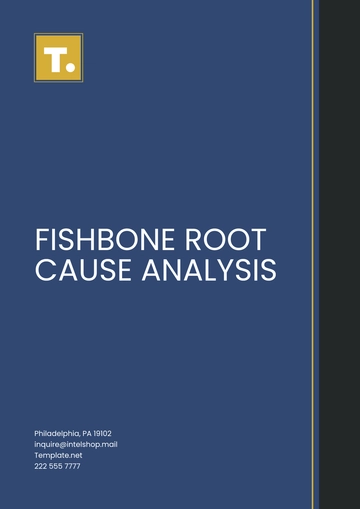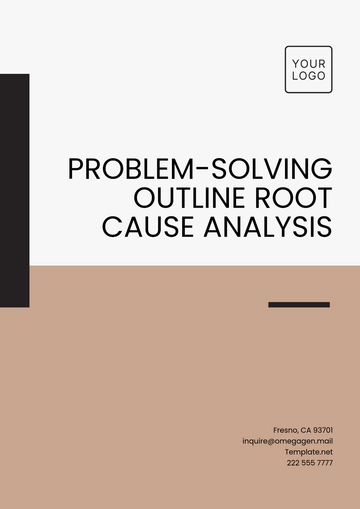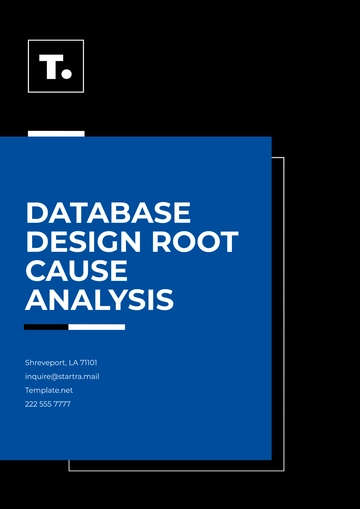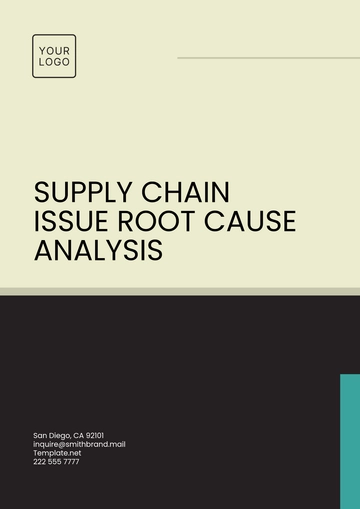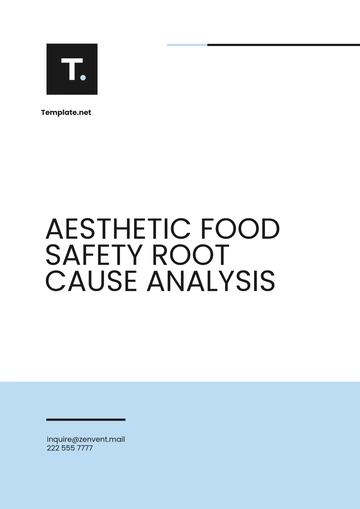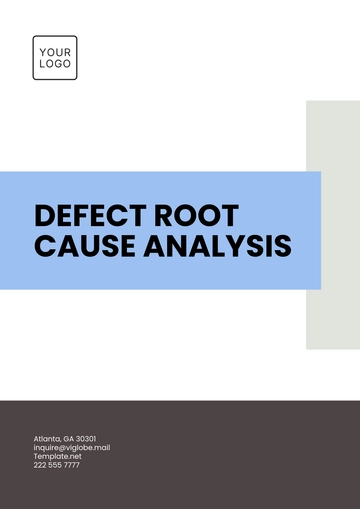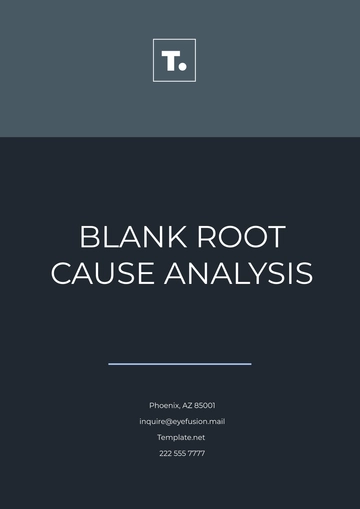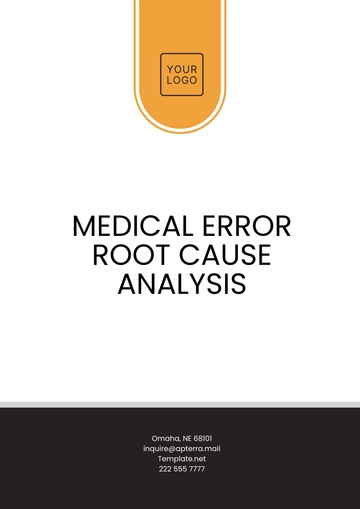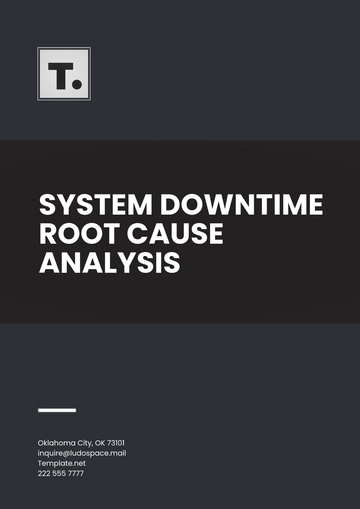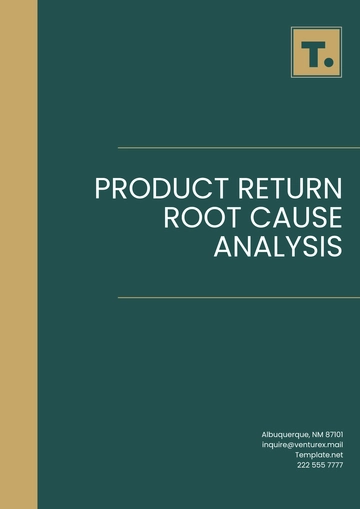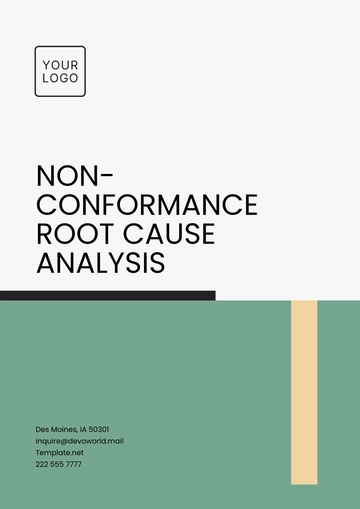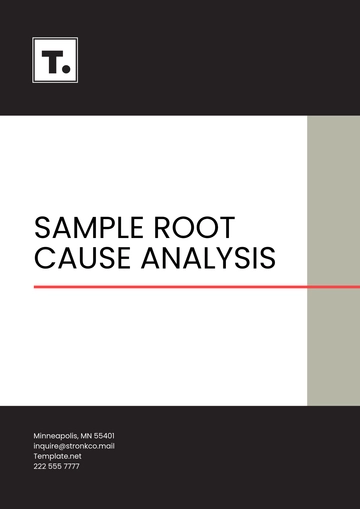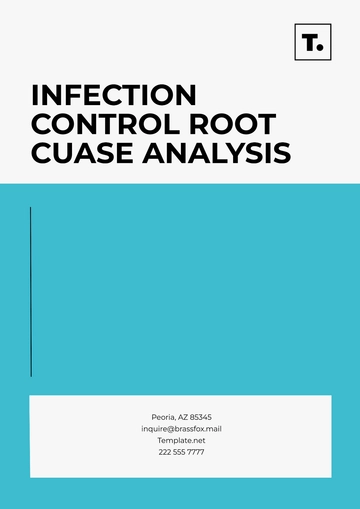Free Pharmaceutical Root Cause Analysis

I. Introduction
A. Purpose of the RCA
The purpose of [Your Company Name]'s Root Cause Analysis (RCA) is to investigate the deviation observed in Batch #2050-15 of [Product Name], which failed to meet the required dissolution rate specifications. By identifying the underlying root cause of the failure, we aim to implement corrective actions that address the issue at its source and prevent similar occurrences. This analysis will also assess the effectiveness of current quality control processes and highlight potential areas for improvement. The end goal is to ensure the product’s quality is maintained, patient safety is assured, and regulatory compliance is upheld.
B. Scope of the RCA
The scope of this RCA is limited to Batch #2050-15, which was produced on March 15, 2050, and encountered issues during routine dissolution testing. The analysis will focus on the manufacturing process, raw materials, equipment, and testing procedures that may have contributed to the dissolution failure. Additionally, we will review any potential environmental factors that could have affected the testing phase, such as temperature and humidity control. A cross-functional team from QA, QC, production, and engineering will collaborate to ensure all relevant factors are explored.
C. Background Information
Batch #2050-15 was flagged during quality control testing on March 17, 2050, after it failed to meet the required dissolution specification of [00]% release within 30 minutes, showing only [00]%. Initial investigations revealed no irregularities with the raw materials or manufacturing records, which raised concerns regarding environmental or procedural issues. The batch was produced using the same equipment and processes as previous batches, making this deviation particularly concerning. The failure was significant enough to warrant a full investigation into potential root causes to ensure the product's suitability for market release.
II. Problem Definition
A. Issue Description
The dissolution test for Batch #2050-15 showed a significant deviation from the acceptance criteria, with only [00]% dissolution achieved within the first 30 minutes, compared to the required [00]%. This failure in the dissolution rate could compromise the bioavailability of the active pharmaceutical ingredient (API), leading to reduced therapeutic efficacy. This non-conformance is especially critical as it affects the final product’s quality and patient safety. As a result, the batch cannot be released without a thorough investigation and resolution of the underlying issue.
B. Impact Assessment
The failure to meet dissolution specifications could result in delays in the product’s release to market, which may lead to financial losses and disruption of supply to healthcare providers. If the issue is not resolved, there could be potential risks to patient safety, particularly if the product is administered without rectifying the dissolution problem. Additionally, the root cause could indicate systemic issues in the manufacturing or testing process that might affect other batches. The deviation must be thoroughly addressed to maintain product quality and prevent regulatory sanctions or product recalls.
III. Data Collection and Review
A. Data Sources
All relevant documentation was reviewed to gather necessary data for the RCA. This included the batch production record for Batch #2050-15, dissolution test results, raw material certificates of analysis (COAs), and the calibration logs for the dissolution testing equipment. Data from previous batches produced under similar conditions was also reviewed to detect any recurring issues. Additionally, relevant Standard Operating Procedures (SOPs) and maintenance records for the dissolution apparatus were analyzed to identify any deviations from standard practices.
B. Document Review
A detailed review of the batch production records confirmed that all raw materials used in the batch were within the specified quality standards, and the manufacturing process followed the approved SOPs. The dissolution test results indicated a consistent pattern of failure across the batch, with no other out-of-spec results noted in earlier tests. During the review of the equipment maintenance logs, it was observed that the dissolution apparatus had undergone minor repairs shortly before the batch’s testing. No signs of deviation in raw materials or equipment calibration were initially found, prompting further investigation into environmental factors and testing procedures.
C. Interview and Inquiry
Interviews with the quality control (QC) and production staff revealed that the dissolution test was conducted in a room that had recently undergone HVAC system maintenance. The maintenance had resulted in fluctuating temperatures, though this was not communicated to the QC team prior to testing. Additionally, the QC analysts did not adjust the testing conditions or take measures to mitigate potential temperature impacts, assuming no significant environmental factors were at play. Production staff were unaware of the maintenance, and no formal risk assessment had been conducted to evaluate the impact of the HVAC maintenance on critical testing parameters.
IV. Root Cause Identification
A. Initial Hypothesis
Based on initial findings, the hypothesis is that the failure in dissolution rate was due to fluctuating temperature conditions in the testing environment. The HVAC maintenance conducted in the testing room may have caused temperature instability, which could affect the solubility of the product and the dissolution test results. Another possibility is that the dissolution apparatus may not have been calibrated correctly, further impacting the reliability of the results. These factors combined could have led to the observed deviation.
B. Analysis Tools
To explore potential causes, a Fishbone Diagram (Ishikawa) was constructed, categorizing potential causes under key headings such as equipment, environment, people, and process. The environment category highlighted temperature fluctuations, which were consistent with the HVAC system’s recent maintenance. Using the 5 Whys method, it was determined that the failure to communicate HVAC maintenance and the absence of environmental monitoring procedures contributed directly to the deviation. A FMEA (Failure Mode and Effect Analysis) confirmed that temperature instability had the most significant impact on the dissolution rate, with equipment calibration being a secondary factor.
C. Root Cause Determination
The root cause of the dissolution failure was determined to be temperature fluctuations in the testing room caused by recent HVAC system maintenance. These fluctuations were not communicated to the QC team, and no immediate action was taken to monitor or correct the testing environment. Although the dissolution apparatus had been calibrated prior to testing, the unstable temperature conditions led to an inaccurate dissolution result. The absence of an environmental control system and lack of clear communication between departments allowed this issue to go undetected until the deviation was flagged.
V. Corrective and Preventive Actions (CAPA)
A. Corrective Actions
Immediate corrective actions include re-testing Batch #2050-15 under controlled, stable temperature conditions to verify the dissolution results. A thorough inspection and recalibration of the dissolution apparatus will be conducted to ensure that all equipment functions within its specified range. Furthermore, a review of the affected batch records will be performed to identify any additional quality concerns, and any affected units will be quarantined until retesting is completed. These actions will help ensure the batch meets the dissolution criteria and can be released for distribution.
B. Preventive Actions
To prevent future occurrences, an updated environmental monitoring protocol will be implemented for all critical testing areas, including dissolution testing rooms. This will include the installation of temperature and humidity sensors to monitor and document environmental conditions during testing, with alarms for out-of-spec conditions. In addition, a formal communication process will be established between the maintenance, production, and QC teams to ensure that any maintenance affecting critical testing environments is scheduled and communicated well in advance. SOPs will be updated to include these new protocols, and staff will be trained accordingly.
C. Effectiveness Monitoring
The effectiveness of these corrective and preventive actions will be monitored through periodic audits of the dissolution testing procedure, focusing on adherence to the new environmental controls. The effectiveness of the new environmental monitoring system will be evaluated through the documentation of temperature and humidity conditions during testing, ensuring they remain within specified limits. A follow-up audit will be scheduled in three months to verify that these measures are implemented correctly and that no similar deviations occur in subsequent batches.
VI. Impact Evaluation and Risk Assessment
A. Risk Assessment
A risk assessment was conducted to evaluate the likelihood and potential impact of similar issues affecting future batches. While the root cause was isolated to Batch #2050-15, there is a risk that future HVAC maintenance could similarly impact testing environments if the corrective actions are not fully implemented. The probability of recurrence has been significantly reduced with the new environmental monitoring and communication protocols in place. However, the risk will remain present until the corrective actions are confirmed as effective.
B. Impact on Other Products/Processes
The environmental instability observed in the dissolution room was specific to Batch #2050-15, but there is a potential risk that other products tested in the same room could be impacted if similar temperature fluctuations occur. A review of other products tested in the same environment will be conducted to ensure that no other batches have been affected. Additionally, all production and testing rooms will undergo a thorough review to ensure consistent environmental controls are in place for all critical testing phases, preventing future disruptions.
VII. Action Plan and Implementation
A. Action Plan Overview
The immediate action plan includes re-testing Batch #2050-15 under stable, controlled environmental conditions and verifying the dissolution results. HVAC system maintenance schedules will be reviewed to ensure no testing occurs during critical maintenance periods. Environmental monitoring systems will be installed in all critical testing areas, and SOPs will be updated to reflect the new procedures for maintaining temperature and humidity control. These actions will help ensure that similar issues do not affect future batches.
B. Roles and Responsibilities
The Quality Assurance (QA) team will be responsible for overseeing the re-testing process and ensuring that environmental monitoring systems are installed. The facilities department will handle HVAC calibration and maintenance scheduling, while the production and QC teams will implement and adhere to the updated SOPs. The training department will be responsible for conducting training sessions on the new procedures and ensuring that all relevant personnel are informed and compliant with the changes.
C. Timeline for Resolution
The corrective actions, including re-testing and equipment calibration, will be completed within two weeks. Environmental monitoring system installation and SOP updates will be finalized within the next month. Follow-up audits and monitoring will take place three months after implementation to assess the effectiveness of the corrective and preventive actions.
VIII. Conclusion
A. Summary of Findings
The RCA confirmed that the failure of Batch #2050-15 to meet dissolution specifications was caused by temperature fluctuations in the testing room due to recent HVAC maintenance. This issue arose from inadequate communication between departments and a lack of environmental controls during critical testing phases. Corrective actions, including re-testing, calibration, and the installation of environmental monitoring systems, have been implemented to prevent recurrence. SOPs and communication protocols will also be updated to ensure better coordination and control.
B. Lessons Learned
The key lesson learned is the importance of proactive environmental monitoring and communication between departments, particularly during maintenance or testing periods. This RCA highlights the need for a robust risk management framework that includes environmental controls as part of routine testing procedures. Moving forward, all critical testing environments will be subject to stricter oversight to ensure that similar issues do not compromise product quality. Additionally, training on these protocols will be essential for continuous improvement.
C. Next Steps
The next steps include completing the re-testing of Batch #2050-15 and ensuring that all corrective actions are implemented effectively. The QA team will perform a follow-up audit in three months to assess the success of the corrective measures and confirm that no similar deviations have occurred. Regular training and updates to SOPs will ensure that all personnel are fully equipped to manage environmental factors during testing, supporting ongoing product quality assurance.
- 100% Customizable, free editor
- Access 1 Million+ Templates, photo’s & graphics
- Download or share as a template
- Click and replace photos, graphics, text, backgrounds
- Resize, crop, AI write & more
- Access advanced editor
The Pharmaceutical Root Cause Analysis Template from Template.net is a fully editable and customizable tool designed to streamline your investigative processes. With its easy-to-use format, this template allows you to quickly adapt and refine your analysis. Enhance your workflow using the intuitive AI Editor Tool for a seamless and efficient root cause exploration experience.
